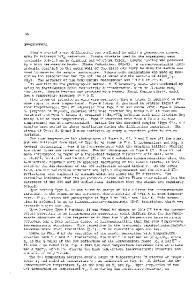Hydration phase transitions and magnetic properties of vermiculite intercalation compounds
- PDF / 637,077 Bytes
- 7 Pages / 595.44 x 841.68 pts Page_size
- 46 Downloads / 425 Views
K. Koga and H. Nishihara Institute for Solid State Physics, University of Tokyo, Minato-ku, Tokyo 106, Japan (Received 29 June 1987; accepted 17 July 1987) Experimental results from x-ray scattering, Raman scattering, neutron scattering, and magnetic susceptibility measurements are presented to discuss hydration states and magnetic orderings in vermiculite intercalation compounds. In Na-vermiculite, the hydration transitions between 2- and 1-water layer hydration states (WLHS), and 1- and 0-WLHS were studied as a function of temperature from 22-200 °C. The transitions are of first order, exhibiting phase coexistence and large hysteresis. In Ni-vermiculite, dc susceptibility measurements showed both magnetic-field directions and hydration dependencies. Also, ac susceptibility and small-angle neutron scattering experiments revealed evidence for magnetic phase transitions in a temperature range between 1.5 and 4 K.
I. INTRODUCTION For many decades, layered silicates (clays) have been studied, and a vast amount of knowledge has been accumulated.1 Recently, advances in the intercalation chemistry have evoked a renewed interest in these minerals as catalysts and catalyst supports.2 They are even considered as possible chemical microreactors in prebiotic synthesis.3 In the physics of porous media, layered silicates play important roles in electromagnetic and transport properties4 and can be discussed in terms of fractal models.5'6 Moreover, because of their anisotropic structure, they are used to examine interesting physical properties such as H 2 superfluidity,7 two-dimensional magnetism,8 mixed-cation effects,9 etc. Even though layered silicates exhibit various structural complexities (e.g., a large unit cell with many isomorphic substitutions, crystalline disorders, etc.), they provide a relatively simple system as far as intercalation processes are concerned. Various cations and molecules can be intercalated without drastically changing the host layers. Clay intercalation compounds (CIC's) may provide as interesting a system as well-studied intercalation systems like graphite and transition-metal dichalcogenide compounds. In order to investigate intercalation processes and related physical properties of layered silicates, we have chosen vermiculite intercalation compounds (VIC's). They are available in large single-crystalline form and exhibit well-defined hydration states. The VIC's are expandable 2:1 layered silicates that can accommodate a discrete number of water layers a)
On leave from Department of Physics, University of Illinois at Urbana-Champaign, Urbana, Illinois 61801. Present address: Department of Physics, State University of New York at Binghamton, Binghamton, New York 13901.
864
J. Mater. Res. 2 (6), Nov/Dec 1987
http://journals.cambridge.org
within the interlamellar space between host silicate layers.1 Each silicate layer is composed of two Si-tetrahedral sheets coupled symmetrically to a Mg-trioctahedral sheet. A net negative charge due to isomorphic substitution of Al 3 + ions with Si 4 + ions
Data Loading...










